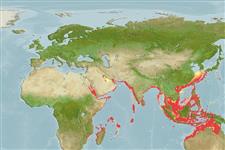Environment: milieu / climate zone / depth range / distribution range
экология
морской демерсальный; пределы глубины 20 - 240 m (Ref. 89707). Tropical; 33°N - 23°S, 35°W - 143°E (Ref. 5222)
Indo-West Pacific: Red Sea, Persian Gulf, Gulf of Oman, Pakistan, India, Viet Nam, Hong Kong, China, Korea, southern Japan, Taiwan, and northwest Australia. Unknown from the east coast of Africa, islands of the Indian Ocean, Indonesia, Philippines, or New Guinea.
Length at first maturity / Size / Вес / Возраст
Maturity: Lm ?, range 86 - ? cm
Max length : 137 cm SL самец/пол неопределен; (Ref. 4787); common length : 70.0 cm TL самец/пол неопределен; (Ref. 5450); наибольший вес (опубликованные данные): 58.6 kg (Ref. 4787)
колючие лучи спинного плавника (общее число): 11; членистые (мягкие) лучи спинного плавника (общее число): 12-14; колючие лучи анального плавника 3; членистые (мягкие) лучи анального плавника: 8. Distinguished by the following characteristics: juveniles are lavender-grey or pale brownish, shading to white ventrally; 2 black-edged white longitudinal bands, upper band extending from above the eye to the anterior dorsal-fin rays, and the lower band from below the eye to the lower band from below the eye to the lower caudal-fin rays; black spots and streaks on dorsal and caudal fins; head and body of large adults, uniformly grey; body depth contained 2.9-3.4 times in SL; head length 2.3-2.6 times in SL; convex interorbital area, convex dorsal head profile; angular preopercle, 3-7 distinctly enlarged serrae at angle; distinctly convex upper edge of operculum; subequal anterior and posterior nostrils; maxilla reaches past vertical at rear edge of eye; 2-3 rows of teeth on midlateral part of lower jaw (Ref. 89707).
Seems to prefer continental localities; bottoms of low relief. Large individuals are taken on coarse sand or rocky areas, while the smaller ones live on silty-sand and muddy bottom. Also caught throughout the year by long-liners (Ref. 5222).
Life cycle and mating behavior
половая зрелость | размножение | нерест | икра | Fecundity | личинки
Heemstra, P.C. and J.E. Randall, 1993. FAO Species Catalogue. Vol. 16. Groupers of the world (family Serranidae, subfamily Epinephelinae). An annotated and illustrated catalogue of the grouper, rockcod, hind, coral grouper and lyretail species known to date. Rome: FAO. FAO Fish. Synop. 125(16):382 p. (Ref. 5222)
Статус Красного Списка МСОП (Ref. 130435)
Угроза для людей
Harmless
Использование человеком
рыболовство: коммерческий
дополнительная информация
ссылкиаквакультура (рыбоводство)особенности рыбоводствастепень растяжениягенетикаElectrophoresesнаследуемостьболезниобработкаNutrientsMass conversion
соавторыизображенияStamps, Coins Misc.звукиCiguateraскоростьтип плаванияжаберная областьOtolithsмозгзрение
инструменты
Специальные отчеты
Скачать в формате XML
ресурсы в Интернет
Estimates based on models
Preferred temperature (Ref.
123201): 19.5 - 28.2, mean 26 °C (based on 902 cells).
Phylogenetic diversity index (Ref.
82804): PD
50 = 0.5000 [Uniqueness, from 0.5 = low to 2.0 = high].
Bayesian length-weight: a=0.01230 (0.00769 - 0.01967), b=3.04 (2.91 - 3.17), in cm total length, based on LWR estimates for this species & Genus-body shape (Ref.
93245).
Trophic level (Ref.
69278): 4.0 ±0.65 se; based on food items.
Generation time: 11.0 ( na - na) years. Estimated as median ln(3)/K based on 2
growth studies.
устойчивость к внешним воздействиям (Ref.
120179): низкий, минимальное время удвоения популяции 4.5-14 лет (tmax=30).
Fishing Vulnerability (Ref.
59153): Very high vulnerability (77 of 100).
Nutrients (Ref.
124155): Calcium = 54.2 [22.6, 119.0] mg/100g; Iron = 0.854 [0.376, 2.031] mg/100g; Protein = 18.1 [16.5, 19.6] %; Omega3 = 0.206 [0.104, 0.397] g/100g; Selenium = 97.8 [46.3, 245.2] μg/100g; VitaminA = 21 [5, 85] μg/100g; Zinc = 0.873 [0.536, 1.456] mg/100g (wet weight);
